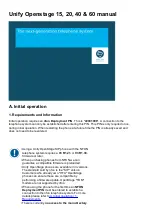
MERLIN LEGEND Communications System Release 5.0
Feature Reference
555-650-110
Issue 1
June 1997
Features
Page 168
Coverage
Call Waiting
A call to a sender with Call Waiting turned on goes to Individual and/or
Group Coverage first. If all coverage points are busy, the sender receives
the call-waiting tone.
Camp-On
Coverage calls answered by any receiver can be camped on to another
user.
Conference
Conference calls can be originated from a Cover button only when the
user with a caller on the Cover button presses the Transfer button, dials
the number for another person, and then presses the Conf button to
complete the transfer. In this case only, instead of the call being
transferred, a conference call with three participants (including the
originator) is established.
CTI Link
When an extension is programmed as a CTI link, it is removed from
membership in coverage groups.
When a call is transferred from a programmed Cover button on a
unmonitored DLC, screen pop is not initiated at the destination extension,
even if it is using a CTI application.
Digital Data Calls
Individual Coverage is not recommended for 2B data calls. Because a
coverage receiver can have only one Cover button for each coverage
sender, only a 1B data call arrives at the receiver. The second call of a 2B
call continues to ring at the coverage sender.
Coverage delays do not apply to data calls. Calls ring immediately.
Coverage is not recommended for video extensions. However, an MLX
passive-bus telephone can be covered during 2B video calls (when both
B-channels are busy), but it must have a programmed Do Not Disturb
button. The user at the telephone activates Do Not Disturb during 2B
calls.
A passive-bus MLX telephone can be a coverage receiver, but this gives
the user little control when B-channels must be available for 2B data.
Direct Station
Selector
When a system operator transfers an Individual or Group Coverage call
and the call returns, the red LED next to the DSS button for the sender
does not flash as it does for a transfer return for calls received on other
types of line buttons.
Direct Voice Mail
Direct Voice Mail overrides coverage-inhibiting features such as
Coverage Off, Coverage VMS Off, and Coverage Inside Off.
Display
When an Individual or Group Coverage call is answered by a receiver
with a display telephone,
Cover
is shown for the call type, followed by the
sender’s name, if programmed, or extension number. The display also
shows the reason why the call went to coverage:
No Ans
,
Busy
, or
DND
.
On an MLX telephone, other reasons why calls are sent to coverage are
also shown:
Invalid/unknown DID number
or
Invalid/unknown
Remote Access number
. The receiver sees the caller information by
pressing the More button.
















































